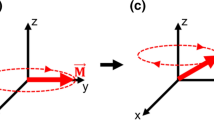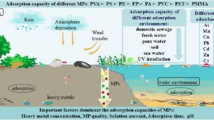Abstract
The partition of elements between seawater and the marine solid phases (organisms and pelagic clays) is basically controlled by the same surface adsorption mechanisms as between soil pore water and the land solid phases (plants and soils). However, the elements in living organisms are separated into ‘biophile’ and ‘biophobe’ groups.
Similar content being viewed by others
References
Balistrieri L., Brewer P. G. and Murray J. W. (1981) Scavenging residence times of trace metals and surface chemistry of sinking particles in the deep ocean. Deep Sea Res. 28A, 101–121.
Banin A. and Navrot J. (1975) Origin of life: clues from relations between chemical compositions of living organisms and natural environments. Science 189, 550–551.
Bennett, J.H. and Manuel O.K. (1968) On iodine abundances in deep sea sediments. J. Geophys. Res. 73, 2302–2303.
Bowen H. J. M. (1966) Trace elements in biochemistry, 240 pp. Academic Press, London.
Bowen H. J. M. (1979) Environmental chemistry of the elements, 333 pp. Academic Press, London.
Byrd J. T. and Andreae M. D. (1982) Tin and methylin species in seawater: concentration and fluxes. Science, 218, 565–569.
Erdman J. A., Shaklette H. T. and Keith J. R. (1976) Elemental composition of selected native plants and associated soils from major vegetation-type areas in Missouri. Geol. Surv. Prof. Paper 954-C 87 pp. U.S. Gov. Printing Office.
Li Y.-H. (1981) Ultimate removal mechanisms of elements from the ocean. Geochim. Cosmochim. Acta 45, 1659–1664.
Li Y.-H. (1982) A brief discussion on the mean oceanic residence time of elements. Geochim. Cosmochim. Acta 46, 2671–2675.
Peterson P. J. (1971) Unusual accumulations of elements by plants and animals. Sci. Prof. Oxf. 59, 505–526.
Quinby-Hunt M.S. and Turekian K.K. (1983) Distribution of elements in seawater. EOS 64, 130–131.
Shishkina O. V. and Pavlova G. A. (1965) Iodine distribution in marine and oceanic bottom muds and in their pore fluids. Geochem. Intern. 559–565.
Turekian K. K. and Wedepohl K. H. (1961) Distribution of the elements in some major units of the earth's crust. Bull. Geol. Soc. Am. 71, 175–192.
Vinogradov A.P. (1959) Geochemistry of rare and dispersed elements in soils, 209 pp. Consultants Bur. Enterprises, New York.
Yamamoto T. (1972) Chemical studies on the seaweeds (27): The relations between concentration factor in seaweeds and residence time of some elements in sea water. Records of Oceangr. Works in Japan, 11, 65–72.
Author information
Authors and Affiliations
Rights and permissions
About this article
Cite this article
Li, YH. Why are the chemical compositions of living organisms so similar?. Schweiz. Z. Hydrologie 46, 177–184 (1984). https://doi.org/10.1007/BF02538059
Received:
Issue Date:
DOI: https://doi.org/10.1007/BF02538059




